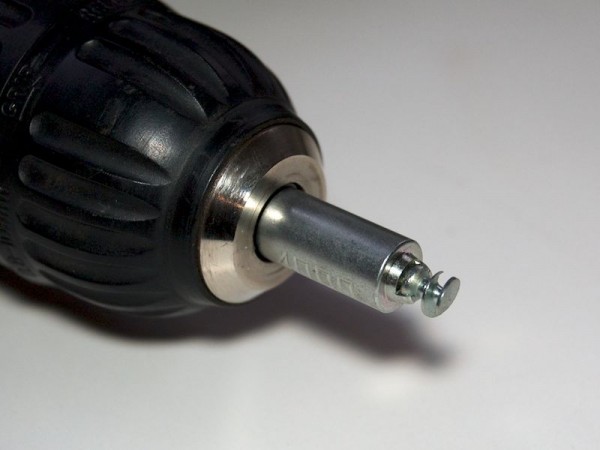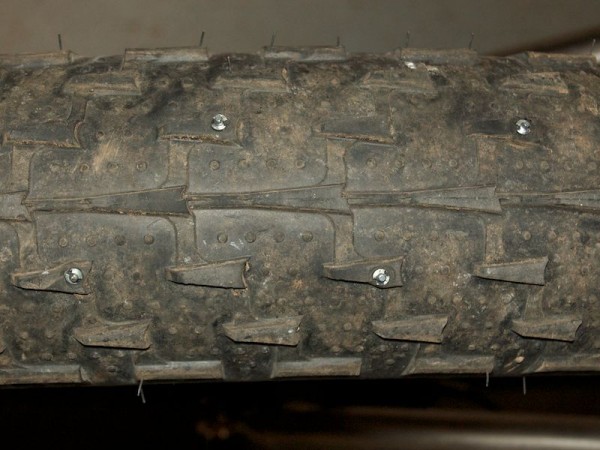Grip Studs recently sent us for review a couple of packages (250 studs total) of their tungsten carbide, screw in studs along with an installation tool for inserting them into your favorite fat-bike tires.
The promise of Grip Studs is a good one; customizable traction with easy to install, wide-auger thread inserts to secure them in your tire. We gave them a go here at FB.C world HQ just to see how the installation process works. Grip Studs recommends installing on an inflated tire while being careful not to go too deep with the stud! The flat plane of the stud should be flush with the surface of the knob on your tire.
The installation tool installed in a variable-speed drill and loaded with a stud ready to insert.
The tire we used for a test was a used Big Fat Larry with several hundred miles on. The knobs have some wear but not excessive. On a new tire there should be at least 2mm of rubber before getting to the carcass of the tire when the stud is fully inserted. Check your tread depth before installing! The studs penetrate in about 6.2mm. A new BFL has about 8mm of rubber. On the studs we installed (4 from a Demo Pack) there was no problem getting the stud flush. We took off the tire to check for any interior penetration and there was none but it is pretty close so make sure you don’t go too deep. Slow and steady is the way to go. Yes, you will want a variable-speed drill!
As far as technique, I used a fair amount of pressure and angled the “tip” of the auger in so it bit right away. I can see why Grip Studs recommends installation on an inflated tire. It gives you something solid to push against.
Stud installed!
This is the beginning of a recommended pattern that offsets each stud resulting in 50 studs to start out with on the BFL. Additional studs can be added, again in an offset pattern on the next row of studs out. It will be interesting to determine how many studs are right for each person and each condition.
This is a shot of the knob that a stud has just been removed from.
This set is off to Chris in the Detroit area who is a year ’round commuter to install them, put them through their paces and tell us what he’s discovered. Look for an initial use report in a few weeks.
Notes:
- The Grip Studs suitable for bicycle use are #GST-1000
- The stepped, Carbide tip is 2.2mm above the “plane” of the stud
- The stud penetrates 6.2mm into the tread
- The Installation Tool is #4000
- Packages are available in 100 or 150 count. If you need custom amounts give Grip Studs a shout!
Disclaimer: Grip Studs provided these studs for review. In addition, they help support the site by advertising. However, regardless of how we get test products, for review from a manufacturer, bought with our own $$$ or borrowed from friends, our reviews will always give our honest opinion and real-world experience!






Very cool. It would also be a good idea to put some in your boots/shoes. The most dangerous part of riding a bike with studs on ice is getting on and off your bike.
I could always stand to be a little more studley
Great to see this is an option, but at $100 for 100 studs, it’s a lot more expensive than buying the best-quality (e.g. Nokian) carbide studded tires. (e.g. $78 for a tire with 240 carbide studs installed).
Just picked up 45NTH Dillengers and had my first ride in variable conditions (ice, roots, light snow, rock, frozen matted leave). They were really good. 240 studs and a 120tpi tire for about the cost of 200 grip studs. I do like the idea of studying my boot lugs though.
I don’t know if i should buy studs for my BFL
or spend my money on escalator. I would like to have
The larger studded knobbies for winter . Any suggestions?
Btw i have clownshoes!